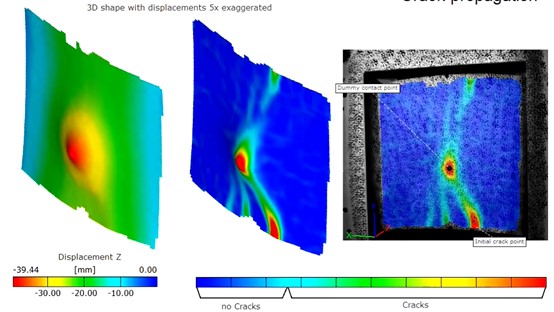3 min read
Optimizing Composite Overwrapped Pressure Vessels with DIC Testing
Walter Schnapp : August 23, 2024 2:52:14 PM EDT
In the world of aerospace engineering and material science, the development of Composite Overwrapped Pressure Vessels (COPVs) marked a significant leap forward in the design and utilization of high-pressure storage solutions thanks to their lightweight and unparalleled high strength-to-weight ratio. However, the true revolution in COPV technology emerged with the advent of Digital Image Correlation (DIC). This innovative testing method has transformed how engineers understand and optimize COPVs, providing unprecedented insights into their behavior under extreme conditions. In this blog post, we explore the unique story of how DIC has revolutionized COPV testing, enabling safer, more efficient, and more reliable pressure vessels for a wide range of applications.
For decades engineers were faced with a unique challenge in measuring COPV and their non-homogeneous structure and their key role in aerospace, but Trilion came along and helped turn a page. With its long-established success record in using optical metrology in the aerospace industry, Trilion's engineers, led by its vice-president, NASA-decorated and foremost expert in aerospace optical testing applications, Tim Schmidt, performed extensive work with various aerospace companies and agencies to make their COPVs safer and increase their longevity.
During a key study performed back in 2007 with NASA on various spherical vessels using high-speed cameras with Digital Image Correlation (DIC) to test for strain and displacement, it was found on one of the vessels that the traditional strain gauges used to measure strain failed to detect any change in the surface despite being only 2 inches from the point of failure.[1] Given the non-homogeneous nature of composite structures, DIC full-field testing is the most effective means of acquiring data. The myriad benefits of using DIC for COPV testing are summarized in the below:
Non-Destructive Testing (NDT):
DIC is non-destructive, meaning it doesn't require physical contact with the specimen. This preserves the integrity of the pressure vessel, making it suitable for assessing the structural health of critical components without causing damage.
High Precision:
DIC provides high precision and accuracy in measuring deformations, strains, and displacements, often at subpixel levels. This level of precision is challenging to achieve with traditional measurement methods. Methods like strain gauges require fore knowledge of where the greatest strain will take place, this is usually not possible in most cases. Additionally, the bonding of a strain gauge to the surface is more challenging and increases the possibility of failure and data loss.
Full-Field Measurements:
DIC allows for full-field measurements, meaning it can capture the deformation and displacement of the entire surface of the pressure vessel. This comprehensive data provides a complete picture of how the vessel responds to various loads or conditions. In scenarios where there is a need for a 360-degree view of a COPV surface during a test, a mirror system can be utilized to see the entire test article.
Real-Time Monitoring:
DIC can be used for real-time monitoring of the pressure vessel's behavior. This capability is valuable for assessing structural performance under dynamic or time-varying conditions. During various testing scenarios when significant pressure is applied, Trilion engineers have identified delamination and potential failure points in the composite weaves taking place on a COPV surface. When the pressure was released and the COPV moved back into the original setting, the woven strands had moved back into the correct position, thus concealing the delamination. DIC testing would be the only methodology that could capture this occurrence.
Material Characterization:
DIC can aid in the characterization of material properties, including elasticity and Poisson's ratio. By analyzing how the composite overwrapped pressure vessel deforms under different loads, you can gain insights into its material behavior. Because of the non-homogenous nature of composites, it is possible for there to be flaws due to manufacturing lapses or other problems, especially in hand-laid items where operator error can play a bigger role. Few testing scenarios other than DIC can accurately capture this data.
Stress Analysis:
DIC provides data that can be used to calculate stresses within the pressure vessel's material. This is crucial for evaluating whether the vessel operates within safe stress limits.
Design Validation:
DIC can help validate the design of composite overwrapped pressure vessels by comparing measured deformations and strains with design expectations or finite element analysis (FEA) predictions. This ensures that the vessel meets safety and performance criteria.
Identifying Weak Points:
DIC can pinpoint areas of high strain or deformation, helping to identify potential weak points in the pressure vessel's design or manufacturing process. This information can guide design improvements and quality control.
Research and Development:
DIC is valuable for research and development efforts aimed at optimizing materials and manufacturing processes for composite overwrapped pressure vessels. It aids in understanding how different factors affect structural performance.
Safety Assurance:
By regularly testing pressure vessels with DIC, you can ensure their ongoing safety and reliability, particularly in critical applications such as aerospace or industrial processes where failure could have serious consequences.
Data Visualization:
DIC provides visual representations of strain and displacement data, making it easier for engineers and researchers to interpret results and communicate findings effectively.
Cost-Effective:
Compared to other advanced measurement techniques, DIC is often a cost-effective option for obtaining detailed deformation and strain data.
Conclusion:
Overall, the benefits of using DIC for testing strain and displacements on composite overwrapped pressure vessels include its non-destructive nature, precision, ability to provide full-field data, and capacity to aid in design optimization and safety assurance. It is a versatile tool for materials testing and structural analysis in various industries.
Strain mapping showing the highest strains in red on the surface of the vessel. [2]
[1] NASA/TM—2007-214938
[2] NASA/TM—2007-214938

Verification of 3D Image Correlation Using Digital High-Speed Cameras
ABSTRACT
Digital Image Correlation: The best Biomechanics Tool for Testing
ABSTRACT


